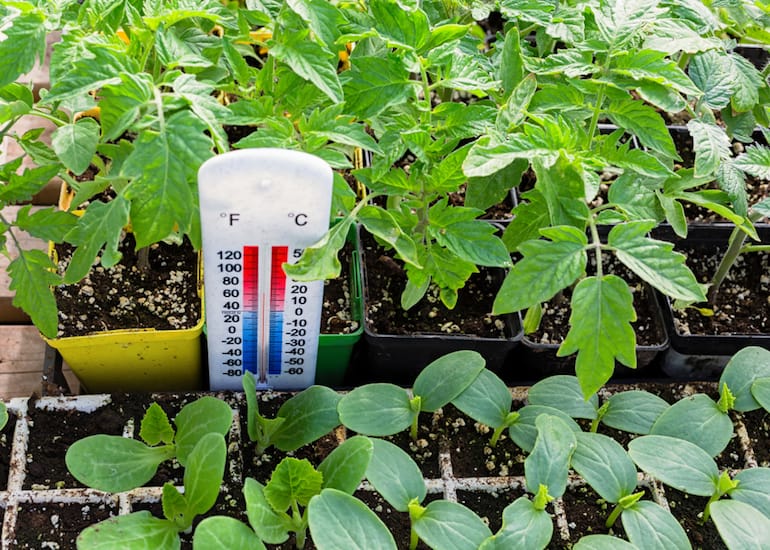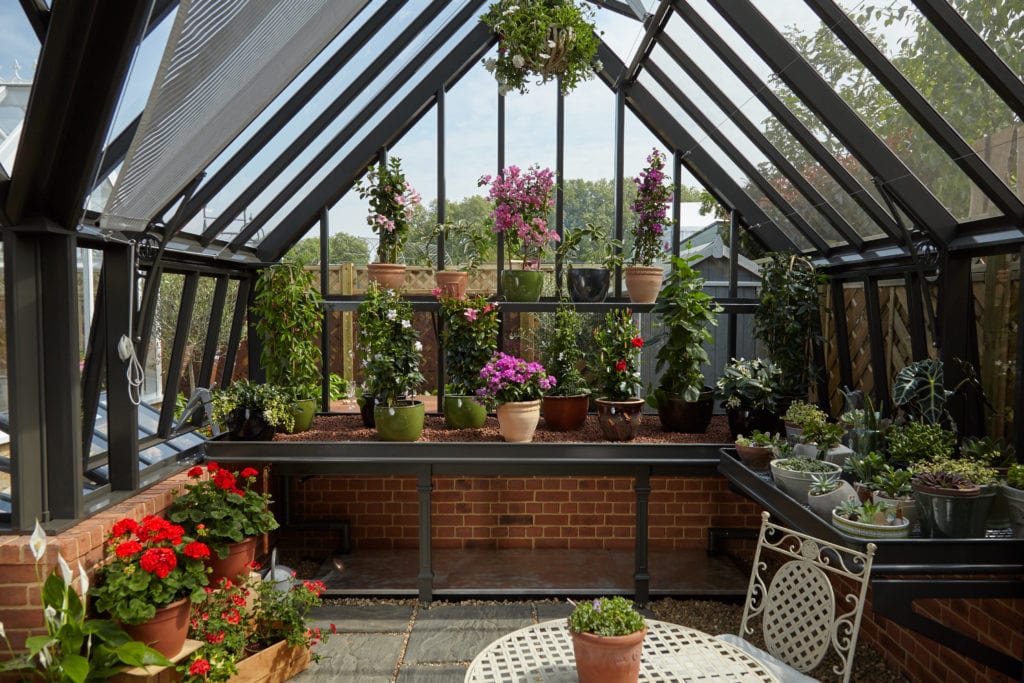Call us at 725-239-9966!
M-F: 8 AM-7 PM PST
Call us at 725-239-9966!
M-F: 8 AM-7 PM PST

Controlling the humidity inside your greenhouse is one of the most important factors for ensuring your plants thrive. While every plant has its own ideal humidity range, most prefer higher humidity levels between 40-60% relative humidity. However, achieving the proper humidity in a greenhouse can be tricky.
In this comprehensive guide, we'll cover everything you need to know about managing humidity in your greenhouse. So, follow along to learn effective methods to control humidity so your greenhouse plants can flourish!

The first step toward controlling humidity is being able to accurately measure the current moisture levels in your greenhouse. For this, you need a reliable hygrometer.
A hygrometer is a small tool that measures relative humidity - i.e. the current amount of moisture in the air compared to the maximum possible moisture at that temperature.
There are analog and digital greenhouse hygrometers available. Digital types tend to be more precise. Place your hygrometer at plant level in a shaded area away from direct sun and check it twice per day.
Monitor the humidity levels in both the morning and afternoon, since humidity fluctuates significantly throughout the day and evening as temperatures rise and fall.
While specific humidity preferences vary by plant, most greenhouse vegetation thrives around 40-80% relative humidity.
Here are the optimal humidity ranges for common greenhouse plants:
Humidity outside of these ranges can lead to a number of problems, including stunted growth, leaf curling, tip burn, powdery mildew, and more.
If humidity dips below 40% RH, you may notice:
Boosting humidity quickly can help reverse these issues.

If your greenhouse humidity reads lower than your plants prefer, there are several effective options to add moisture to the air:
A cool mist humidifier is the most direct way to raise humidity as needed. There are many affordable, small humidifiers designed explicitly for greenhouse use.
Place the humidifier on the greenhouse floor or hang it above the plants. Clean and refill it regularly with distilled water to prevent mineral deposits. Run it whenever the hygrometer reads below the target humidity.
Humidity from misting rapidly dissipates. A greenhouse humidifier provides lasting humidity to the entire space.
Hand misting plants or watering nearby raises local humidity briefly as the water evaporates into the surrounding air.
However, the effects are temporary. You need constant misting to maintain the ideal humidity. This can encourage mold growth so take care to not overdo it.
Misting is helpful to boost humidity in hotspots as needed. But for whole-greenhouse humidity control, a humidifier works better.
Swamp coolers or evaporative coolers are an excellent way to add cooling and humidity at the same time.
As the water evaporates from the cooler’s saturated pads, it introduces moisture into the greenhouse air. Position it near plants that prefer extra humidity.
Evaporative coolers naturally raise humidity levels by 10-15% RH on average - a significant boost!
Cracking open a greenhouse vent allows outdoor humidity to intermix with the air inside. This effect is most noticeable on humid days.
Venting alone usually isn’t enough to make a big humidity impact in dry climates. But when combined with other methods like misting or humidifiers, it can help regulate moisture levels.
Open vents also when humidity gets too high to allow moist air to escape and drier air to enter.
Here’s an all-natural way to increase humidity - grow more plants!
Adding more plants introduces more moisture into the greenhouse as the plants transpire. Greens with many leaves or big tropicals give off the most humidity.
Group plants together to combine their humidifying power. Just monitor that airflow isn’t hampered, or diseases may develop.
Here is a comparison of the main humidity-boosting methods:
| Method | Pros | Cons |
|---|---|---|
| Humidifier | Effective for the whole greenhouse | Requires maintenance |
| Misting | Boosts local humidity | Temporary, risks of mold |
| Evaporative cooler | Adds humidity and cooling | Only near cooler |
| Venting | Uses natural outdoor humidity | Limited effect |
| More plants | All-natural | Needs adequate airflow |
As you can see, each method has its own pros and cons. Using a combination of these techniques is often the most effective for comprehensively increasing greenhouse humidity.

To control humidity, you also need to manage greenhouse temperatures. There is a direct, inverse relationship between heat and humidity in an enclosed greenhouse environment.
As the greenhouse air warms up, its capacity to hold moisture increases. This causes the relative humidity percentage to drop even if the actual moisture content stays the same.
Some strategies to balance both temperature and humidity include:
Keep track of both the heating and humidity in your greenhouse using a thermometer-hygrometer combo meter.
Check the readings at the same times daily - early morning and late afternoon are best.
Turning down your greenhouse heater or exhaust fan slightly can allow more moisture to accumulate in the air instead of being driven out.
Just be sure temperatures don’t drop too low for your plants. Reduce heating gradually and monitor the effects on humidity.
Adding humidity via misting, humidifiers, or damp surfaces gives needed moisture without lowering the temperature.
This prevents humidity from rising at the cost of warmth.
Adding greenhouse insulation helps retain both precious heat and moisture during cooler weather.
Sealing drafty cracks also keeps humidity inside instead of escaping.
Proper insulation means you use less heating to save costs while maintaining humidity!
Spot heat problem areas using heating mats or grow lights to raise cold microclimates a few vital degrees.
This prevents condensation from forming in those chilled zones that can drive down overall humidity.
Careful heating adjustments like these can work wonders for balancing humidity and temperature!

The best approach is to find the perfect combination of warmth and humidity in your greenhouse to keep both at optimal levels together.
Follow these tips for ideal heat and humidity balance:
Check your greenhouse hygrometer and thermometer several times a day during both warm and cool weather. Keep detailed records.
Stay vigilant to any humidity or temperature swings. Catching issues early makes corrections easier.
Don’t overcorrect with drastic heating or humidifying changes when working toward proper balance. Make small, incremental changes and give them time to take effect.
For example, raise your humidifier output by 5% or reduce heater runtime by 10 minutes. Make more adjustments after monitoring results.
The ideal humidity and temperature balance will shift over the seasons as outdoor conditions change.
For instance, use lower heater settings combined with more ventilation in spring to manage higher natural humidity.
In winter, dial back misting and humidification while increasing greenhouse heating.
The most accurate indicators of ideal greenhouse conditions are the plants themselves!
If they show signs of high humidity or low humidity, make appropriate corrections.
Healthy, vigorously growing plants reflect proper heat and humidity balance.

Properly regulating humidity is a complex but vital task in greenhouse gardening. Careful monitoring, gradual adjustments, and balancing temperature are key to controlling moisture levels. With a hygrometer, humidifier, and proper ventilation, you can create ideal humidity for healthy, vigorous plants.
Managing greenhouse humidity does require diligence, but the rewards are abundant in robust vegetation and bountiful harvests. Achieving the right humidity balance contributes to your greenhouse becoming a sanctuary where your plants can flourish.
Many plants thrive best with 40-60% relative humidity. Increasing humidity in the greenhouse prevents issues like wilting, crisp leaves, slow growth, and tip burn.
High humidity causes issues like mold, rot, and droplets on leaves. Low humidity leads to dry, crispy leaves and stunted growth.
Higher temperatures allow air to hold more moisture, lowering relative humidity. Cooler air temperatures cause relative humidity levels to rise.
Excessive misting, lack of airflow, dense foliage, and cool temperatures cause humidity buildup. Venting, fans, dehumidifiers, and reduced watering can lower it.
To reduce humidity in a greenhouse, ventilate the greenhouse by opening doors or windows, use exhaust fans, run a dehumidifier, and avoid excessive misting or watering. Reduce heating to let humidity escape.
Managing greenhouse humidity prevents leaf damage, diseases, stunted growth, and wilting. Proper humidity is essential for plant health.

{"one"=>"Select 2 or 3 items to compare", "other"=>"{{ count }} of 3 items selected"}
Leave a comment